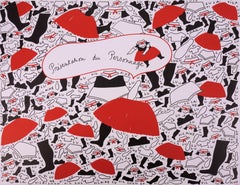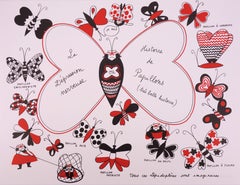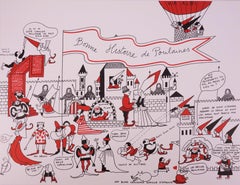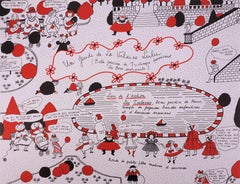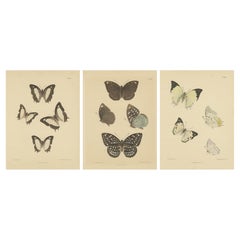Set Of Lithographs
1980s Modern Figurative Prints
Lithograph
1980s Modern Figurative Prints
Lithograph
1980s Modern Figurative Prints
Lithograph
1980s Modern Figurative Prints
Lithograph
1980s Modern Figurative Prints
Lithograph
1980s Modern Figurative Prints
Lithograph
1980s Modern Figurative Prints
Lithograph
1950s Modern More Prints
Lithograph
Antique 1870s Prints
Paper
1980s Prints and Multiples
Paper
1980s Expressionist Landscape Prints
Paper, Ink, Lithograph
1980s Figurative Prints
Paper, Ink, Lithograph
1960s Prints and Multiples
Lithograph
1980s American Modern Figurative Prints
Laid Paper, Lithograph, Acrylic
1980s Expressionist Figurative Prints
Paper, Ink, Lithograph
Antique 19th Century British Paintings
Paint
Early 1900s Art Nouveau Interior Prints
Lithograph
Vintage 1980s Prints
Glass
Early 19th Century Other Art Style Prints and Multiples
Paper
Antique Early 19th Century Swiss William IV Prints
Mahogany
Early 20th Century Swedish Gustavian Prints
Glass, Wood, Paper
Antique Mid-19th Century Prints
Paper
Antique 1850s English Prints
Gold, Gold Leaf
Antique 19th Century Prints
Wood, Paper
1990s Modern Paintings
Paper
Early 19th Century Victorian Landscape Drawings and Watercolors
Paper, Watercolor
Mid-20th Century Modern Prints and Multiples
Lithograph
Antique 1850s European Sporting Art Sports Equipment and Memorabilia
Paper
1820s Victorian Still-life Prints
Watercolor, Lithograph
Antique 18th Century Italian Prints
Glass, Wood, Paper
Vintage 1970s Modern Prints
Paper
1980s Conceptual Landscape Prints
Lithograph
1990s Abstract Expressionist Abstract Prints
Archival Paper, Lithograph
1970s Prints and Multiples
Lithograph
1870s Victorian Animal Prints
Watercolor, Lithograph
1850s Victorian Animal Prints
Watercolor, Lithograph
1980s Abstract Expressionist Abstract Prints
Gold Leaf
1820s Victorian Still-life Prints
Watercolor, Lithograph
1820s Victorian Still-life Prints
Watercolor, Lithograph
20th Century Italian Renaissance Paintings
Paper
Antique Early 19th Century German Prints
Paper
Vintage 1970s French Prints
Glass, Wood, Paper
20th Century Drawings
Paper
Early 20th Century Figurative Prints
Lithograph
1950s American Modern Color Photography
Lithograph
Antique 19th Century Italian Art Nouveau Prints
Paper
Antique 1890s Australian Prints
Lucite, Paper
20th Century Art Nouveau Figurative Prints
Lithograph
1970s Abstract Prints and Multiples
Lithograph
20th Century Land Figurative Prints
Lithograph, Screen
Early 20th Century Industrial Prints
Glass, Wood
1970s Abstract Abstract Prints
Lithograph
Vintage 1980s French Prints
Glass, Wood, Paper
Antique Late 19th Century English Prints
Paper
Antique Mid-19th Century French Prints
Paper
Antique Late 19th Century English Prints
Paper
Antique 1870s English Other Prints
Gold Leaf
- 1
- ...
Set Of Lithographs For Sale on 1stDibs
How Much are Set Of Lithographs?
- What is an after lithograph?2 Answers1stDibs ExpertApril 5, 2022A lithograph is a piece of artwork created using oil and water. An after lithograph is a copy of an existing painting done after the original painting’s creation. Pablo Picasso would have after lithographs created of his famous works, usually by another approved artist. On 1stDibs, find a collection of lithographs from some of the world’s top sellers.1stDibs ExpertApril 5, 2022An “after” lithograph, or after print, refers to a print that is made by an artist based on an original painting or a work by a different artist. For example, a lithographer could make an engraving based on a painting by Picasso, and the resulting print would be “after” Picasso. Shop a collection of after lithography from some of the world’s top art dealers on 1stDibs.
- 1stDibs ExpertNovember 20, 2024The difference between a lithograph and a lithograph print depends on the context. By the strictest definition, the terms are actually synonyms. A lithograph is the term for a print produced through a specific process. It begins with an artist drawing or painting on a stone surface with an oil-based substance, such as a greasy crayon or tusche. The stone is then covered with water, which is repelled by the oily areas. Oil-based ink is then applied to the wet stone, adhering only to the oily image. The stone is then covered with a sheet of paper and run through a press. You can call a print produced with this printmaking method a lithograph, a lithograph print or a lithographic print. However, some people may use the term lithograph to describe a traditional lithograph and lithograph print to denote an offset lithograph. Offset lithography is a method of mass-producing prints where the image from the stone gets transferred to a rubber blanket, which is then pressed against the paper to produce a final image. Find a wide variety of lithographs on 1stDibs.
- 1stDibs ExpertOctober 7, 2024The difference between an offset lithograph and an original lithograph is that the former is made using the other. To produce an original lithograph, a printmaker begins by drawing on or painting on a stone surface with an oil-based substance. The stone is then covered with water, which is repelled by the oily areas. Oil-based ink is then applied to the wet stone, adhering only to the oily image. The stone is then covered with a sheet of paper and run through a press. An offset lithograph is a copy of an original lithograph produced with mechanical processes, usually without the artist's involvement. On 1stDibs, explore a collection of lithographs and other art prints.
- Are Lithographs Valuable?1 Answer1stDibs ExpertFebruary 22, 2021The most valuable lithographs are ones made by the artist, rather than someone mimicking a famous work of art. Original lithographs can be worth tens of thousands of dollars.
- 1stDibs ExpertFebruary 13, 2023Yes, there is a market for lithographs. However, demand for this type of artwork varies based on the artist, subject, age, condition and other factors. Fine art prints are created in strictly limited editions — of 20 or 30 or maybe 50 — and are always based on an image created specifically to be made into an edition. Because an artist’s editions tend to be more affordable and available than his or her unique works, new collectors are often directed toward prints as a starting point. Experts suggest that as collecting prints online has become more common, the market for lithographs and other kinds of prints is poised to flourish in the years to come. On 1stDibs, find a variety of lithographs and other prints from some of the world’s top galleries.
- What is a genuine lithograph?1 Answer1stDibs ExpertApril 5, 2022A genuine lithograph is when an artist creates a piece of art on a stone or metal plate that is re-inked every time the image is pressed to paper. To ensure you purchase authentic, high-quality lithographs, look for a reputable seller. Shop a selection of expertly vetted lithograph art on 1stDibs.
- 1stDibs ExpertJune 6, 2024Lithographs are so expensive largely because of their properties. Compared to other types of prints, they tend to be more painterly, meaning they are better at capturing the qualities of color, stroke and texture featured in an original image. Since they bring paintings and other images to life in rich detail, artists and dealers can sell them for higher prices. Lithographs may also be expensive due to their rarity or creation by a famous artist. Shop a large selection of lithographs on 1stDibs.
- Who is a famous lithographer?1 Answer1stDibs ExpertJanuary 27, 2025There are many famous lithographers. One was Alois Senefelder. Sometimes called the “Father of Lithography,” he accidentally discovered the printmaking technique in 1796 when trying to find a new way to make copies of his plays. His discovery eventually led to the use of lithography to produce artwork. During the 18th century, artists who experimented with the technique included Honoré Daumier and Henri de Toulouse-Lautrec.
Lithography became an even more popular art form during the 20th century when it was used by artists like Alphonse Mucha, Marc Chagall, Edvard Munch, Pablo Picasso, Joan Miró, Diego Rivera and Käthe Kollwitz.
Find a wide range of lithographs on 1stDibs. - What is a signed lithograph?1 Answer1stDibs ExpertApril 16, 2024A signed lithograph is an art print produced with a particular method that bears the artist's real signature, signed in ink. The term lithograph refers to a print made by drawing an image onto a stone, etching the stone with chemicals and then applying ink. The term signed lithograph is different from a plate-signed lithograph, where the artist adds their signature to the stone to transfer it onto finished prints rather than signing their works by hand. Explore a large collection of lithographs on 1stDibs.
- What is a color lithograph?1 Answer1stDibs ExpertMay 3, 2024A color lithograph is a print produced through the process of chromolithography. Unlike traditional lithography, which uses a single stone and one color of ink, chromolithography involves multiple printing stones, each of which corresponds to a single color. Artists etch the stones with only the elements of the image that will show up in that color, then transfer the image, part by part and color by color, onto paper. Find a range of color lithographs on 1stDibs.
- Is a lithograph an original?1 Answer1stDibs ExpertApril 16, 2024No, a lithograph is not an original. Lithographs are prints, which are authorized reproductions of works produced by artists. To produce a lithograph, an artist applies an image to a stone. Then, they treat the stone with chemicals to impart the image into it. Finally, they apply ink and transfer the image onto paper or another medium. Shop a large selection of lithographs on 1stDibs.
- What is a lithograph poster?1 Answer
 International Fine Arts Consortium - IFAC ArtsMarch 22, 2021It's a print using an offset lithograph press. Although still used today it has been primarily replaced with digital printing.
International Fine Arts Consortium - IFAC ArtsMarch 22, 2021It's a print using an offset lithograph press. Although still used today it has been primarily replaced with digital printing. - What is a numbered lithograph?1 AnswerLilac Gallery Ltd.March 17, 2021When a lithograph is numbered by the artist, it means that this particular artwork is from a 'limited edition' series. As when the lithographs are not numbered, they would be from an open edition and the total number similar of artworks is unknown. When a lithograph is numbered it usually also comes hand-signed by the artist.
- What is an original lithograph?1 Answer1stDibs ExpertOctober 19, 2021An original lithograph is a print made by way of a specific printing method (one of the most commonly used methods in the 20th and 21st centuries). With respect to lithography, the process begins by drawing on or painting on a stone surface with an oil-based substance, such as a greasy crayon or tusche (an oily wash). The stone is then covered with water, which is repelled by the oily areas. Oil-based ink is then applied to the wet stone, adhering only to the oily image. The stone is then covered with a sheet of paper and run through a press.
- 1stDibs ExpertSeptember 25, 2019
In a hand-pulled lithograph, the image is painted or drawn by hand on the plate, which is then inked and used to make an impression on the print medium; in an offset lithograph, the inked image is transferred to a rubber blanket or roller, which is then used to mass-produce the prints.
- Does Banksy make lithographs?1 Answer1stDibs ExpertApril 5, 2022Yes, Banksy makes lithographs. The anonymous English-based artist primarily works in street art and has reproduced his work through stencil work, silkscreens and lithographs. These reproductions are often imitated. Always purchase Banksy prints from a reputable seller to ensure authenticity. Shop a large collection of expertly vetted Banksy prints from some of the world’s top sellers on 1stDibs.
- 1stDibs ExpertAugust 15, 2024To tell the difference between a lithograph and a print, touch the surface of the piece. Lithographs will usually have a slightly raised texture, whereas reproductions of lithographs produced with other techniques are more likely to be smooth. Then, examine the surface closely with a magnifying glass.
On a lithograph, you will typically see irregularities in the dot pattern. Printed reproductions normally don't display such irregularities due to the mechanical processes used to produce them. If you're still uncertain, a certified appraiser or knowledgeable art dealer can help you determine whether a piece is a lithograph or a reproduction print.
On 1stDibs, explore a large selection of lithographs and prints. - 1stDibs ExpertAugust 26, 2024The difference between a lithograph and an original is that one is used to produce the other. An original is the term for the stone upon which an artist paints an image using an oil-based substance, such as a greasy crayon or tusche, a type of oily wash. The lithograph is the print that an artist makes with an original. To create a lithograph, oil-based ink is applied to the wet stone, adhering only to the oily image. The stone is then covered with a sheet of paper and run through a press. On 1stDibs, shop a diverse assortment of lithographs.
- 1stDibs ExpertJune 13, 2024The difference between a print and a lithograph is that “print” is a general term and “lithograph” is a specific printing method (one of the most commonly used in the 20th and 21st centuries). This means that a lithograph is always a print, but not all prints are lithographs. A print is a work of art made by imprinting a design from a matrix made of one of the following media: stone, wood or metal. The artist creates the design on the matrix which is then inked and transferred onto the support. The support is usually made of paper. With respect to lithography, the process begins by drawing on or painting on a stone surface with an oil-based substance, such as a greasy crayon or tusche (an oily wash). The stone is then covered with water, which is repelled by the oily areas. Oil-based ink is then applied to the wet stone, adhering only to the oily image. The stone is then covered with a sheet of paper and run through a press.
Find lithographs and other types of art prints for sale on 1stDibs. - 1stDibs ExpertOctober 24, 2024To tell a lithograph from an etching, look closely along the edges of the print. Etching is a way of incising lines on a metal plate by first drawing on an acid-resistant coating, or ground, to reveal the metal beneath. Lithography uses a stone rather than a plate. As a result, etchings will usually have a faint imprint or indentation called a plate mark, while a lithograph will not. Researching the artist using trusted online resources may also be helpful, as some printmakers worked exclusively with etchings or lithographs. Find a large selection of lithographs and etchings on 1stDibs.
Read More
Revisiting Robert Rauschenberg’s Creative Rebellion on His 100th Birthday
A planet-wide celebration feels fitting for an artist who saw connections everywhere: between paint and photography, art and life, self and surroundings.
Red Grooms’s 3D Tugboat Is a Chaotic, Comic Take on New York Life
The sculptural lithograph is part of the inimitable artist’s “Ruckus” series, now on view at the Brooklyn Museum.
Joan Mitchell’s Rare, Late-Career Diptych Buzzes with Life
Beneath the inky blackness, the painter’s irrepressible energy electrifies this pair of intaglio prints.
The 1stDibs Guide to Types of Abstract Art
Get to know the key movements and artists who have influenced visual culture for more than a century.
Romare Bearden’s Humanity Infuses His Bright, Bold Art
Through collage, painting and printmaking, the artist foregrounded Black life in America in revolutionary new ways.
Andy Warhol and Suzie Frankfurt’s ‘Wild Raspberries’ Cookbook Is an Artful, Fanciful Delight
This set of recipes and original prints might not make you a better chef. But it will make you smile.
Art Brings the Drama in These Intriguing 1stDibs 50 Spaces
The world’s top designers explain how they display art to elicit the natural (and supernatural) energy of home interiors.
Welcome (Back) to the Wild, Wonderful World of Walasse Ting
Americans are rediscovering the globe-trotting painter and poet, who was connected to all sorts of art movements across a long and varied career.
